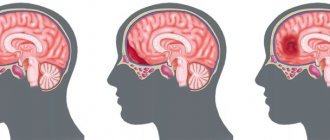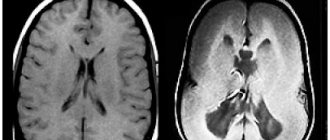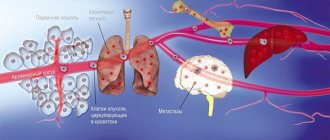Classification of hemorrhages in newborns
Subarachnoid hemorrhage in a newborn
One of the most common types of hemorrhages in children is subarachnoid. Its cause is the rupture of blood vessels inside the arachnoid and soft membranes of the brain. Most often, the cause may be prolonged labor. If the problem is not recognized in time, an inflammatory process begins due to the breakdown of blood at the site of bleeding.
Main symptoms:
- Overexcitement, poor sleep;
- Constant crying;
- Strabismus;
- Increased head volume;
- Convulsions;
- Neck muscle tension.
With immediate detection of the disease and proper treatment, hemorrhage leaves no consequences.
Subdural hemorrhages in newborns
Subdural hemorrhage in newborns is caused by rupture of venous vessels.
This type of damage is caused by acute trauma. It leads to an outpouring of blood into the area between the dura mater and the brain. A hematoma forms, which rapidly increases and compresses the brain. The consequences of such a pathology are very dangerous and can lead to death.
In addition to injuries, aneurysms and brain tumors can lead to subdural bleeding.
The most common causes of this hemorrhage are the following:
- The fruit is too large;
- Rigidity of the uterus (in women giving birth for the first time and during late labor);
- The rapidity or protracted nature of labor;
- Vacuum extraction or turning of the baby during labor;
- Prematurity (too soft skull bones).
Symptoms of subdural bleeding in newborns:
- Muscle tension in the back of the head;
- Throwing back the head;
- Non-response of the pupil to light;
- Bradycardia;
- Cramps.
The condition of a child with this pathology is serious; death can occur within two days.
With immediate diagnosis and removal of the hematoma, in half of the cases it is possible to save the newborn a full life. The rest experience serious damage to the neurological system, hydrocephalus and death.
Intraventricular hemorrhage in a newborn
Asphyxia and hypoxia lead to the development of intraventricular hemorrhage in infants. At risk are premature babies whose circulatory system and structural parts of the brain are not fully formed. In babies born prematurely, the head contains the germinal matrix, a structure that later turns into the framework of the brain. With IVH, the process of transformation of the matrix is disrupted, which leads to a delay in the development of the child
This pathology has four degrees of severity. In the first two, there are no symptoms or consequences of the disease, and its presence is diagnosed only by tomography and sonography. In the third and fourth degrees, hydrocephalus begins, the spread of bleeding to brain tissue, and, as a result, neurological changes.
Subependymal hemorrhage in newborns
Subependymal hemorrhage occurs due to cerebral hypoxia. Symptoms in newborn babies include:
- Hand hypotension;
- Mild changes in excitement and lethargy;
- Excessive eye mobility;
- Unsharp tilting of the head.
An indicative sign of this condition is repeated attacks of apnea. To identify the disease, the baby undergoes neurosonography. It is not always possible to recognize SEC in the first hours of life. Often, symptoms appear in the second week or even several months after birth. A prolonged course of the disease leads to the formation of a cyst in the brain.
Parenchymal hemorrhage in a newborn
A complication of IVH can be blood entering the brain. This process is called parenchymatosis.
The pathology begins due to brain damage from a viral infection or blood clotting disorders in the child (difference in the Rh factors of the baby and the mother). Causes may include asphyxia or birth trauma.
With such bleeding there is a high risk to the baby's life. If the outcome is positive, after the hematoma resolves, a cyst forms, which occupies the affected area of the brain. This process leads to serious neurological impairment and developmental delays.
Treatment of hemorrhages in newborns
Treatment of hemorrhages in infants is mainly supportive in nature, with the exception of cases when surgical intervention is required to eliminate hematomas. All children receive vitamin K, which helps resolve blood clots. For certain indications, they are prescribed clotting factors
A sick baby is protected from noise and bright light. To completely eliminate any stress, they are fed through a feeding tube.
Basic principles of caring for a newborn with hemorrhage:
- You should not make sudden movements when changing clothes and bathing your baby;
- Care should be taken to ensure that the child does not fall or lean head down;
- It is necessary to constantly monitor body temperature to detect exacerbations of the condition.
Causes of hemorrhage in newborns
Bleeding in the brain occurs due to damage to the vessels inside the skull. Blood enters the lining of the brain. Vascular rupture is caused by injury or hypoxia.
Medical studies have shown that bleeding in newborns can be caused by:
- Violation of pregnancy terms (not full-term or post-term baby);
- Large head circumference of the baby and unpreparedness of the mother’s birth canal;
- Mycoplasma, hypoxia, intrauterine infectious diseases;
- Long or short labor;
- Medical errors during childbirth.
To accurately identify pathology, a tomography of the baby’s head is performed.
Manifestations of IVH in young children
Up to 90% of all hemorrhages in the ventricular system occur in the first three days of a baby’s life, and the lower his weight, the higher the likelihood of pathology. After the first week of a child’s life, the risk of hemorrhage decreases significantly, which is associated with the adaptation of the vascular system to new conditions and the maturation of the structures of the germinal matrix. If the child was born prematurely, then during the first days he should be under close supervision of neonatologists - on the 2-3rd day the condition may worsen sharply due to the onset of IVH.
Small subependymal hemorrhages and grade 1 IVH may be asymptomatic. If the disease does not progress, the condition of the newborn will remain stable, and neurological symptoms will not even arise. With multiple hemorrhages under the ependyma, signs of brain damage will appear closer to a year with the phenomena of leukomalacia.
A typical intracerebral hemorrhage is manifested by symptoms such as:
- Decreased muscle tone;
- Sluggish tendon reflexes;
- Breathing disorders up to stopping (apnea);
- Convulsions;
- Focal neurological symptoms;
- Coma.
The severity of the pathology and the characteristics of the symptoms are associated with the volume of blood entering the ventricular system and the rate of increase in pressure in the cranial cavity. Minimal IVH, which does not cause obstruction of the cerebrospinal fluid ducts and changes in the volume of the ventricles, will be accompanied by an asymptomatic course, and it can be suspected by a decrease in the hematocrit number in the baby’s blood.










